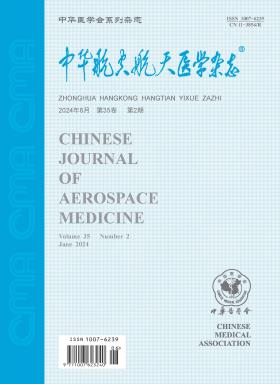星形胶质细胞和小胶质细胞对减压病兔脊髓损伤的影响
引用次数: 0
摘要
目的探讨星形胶质细胞和小胶质细胞在减压病(DCS)兔脊髓损伤中的作用。方法21只健康成年雄性新西兰兔按随机数字表法平均分为3组:对照组、安全缓解组和DCS组。实验动物被放置在压力舱中。安全卸压组模型参考中国海军潜水减压表减压时应用。DCS组在5 min内通过压缩空气将压力均匀升高至0.8 MPa(绝对压力),维持60 min后在5 min内均匀减压至常压。光镜下观察胸腰椎脊髓病理形态的变化。实时聚合酶链式反应(real-time PCR)检测肿瘤坏死因子-α (TNF-α)和胶质原纤维酸性蛋白(GFAP) mRNA的表达,免疫组织化学法检测TNF-α、GFAP、离子钙结合接头分子1 (IBA1)蛋白的表达。结果DCS组脊髓白质可见空腔形成。DCS组TNF-α mRNA相对表达量(6.28±1.73)高于对照组(1.00±0.14)和安全缓解组(1.34±0.42)(P<0.01)。DCS组GFAP mRNA相对表达量(7.39±2.04)高于对照组(1.02±0.26)和安全缓解组(1.63±0.90)(P<0.01)。DCS组TNF-α蛋白表达(24.14±2.61)明显高于对照组(6.71±1.25)和安全缓解组(8.28±1.11)(P<0.01)。DCS组GFAP蛋白表达量(18.20±4.38)明显高于对照组(4.30±2.70)和安全缓解组(6.20±2.92)(P<0.01)。DCS组IBA1蛋白表达量(21.53±1.37)显著高于对照组(5.94±0.36)和安全缓解组(6.69±0.81)(P<0.01)。结论星形胶质细胞和小胶质细胞可能在脊髓损伤的病理生理中起关键作用。它们在DCS早期被激活,伴随着TNF-α的大量释放,引起过度的炎症反应,最终诱发脊髓损伤。关键词:减压病;脊髓损伤;星形胶质细胞;小胶质细胞;肿瘤坏死因子本文章由计算机程序翻译,如有差异,请以英文原文为准。
Effects of astrocyte and microglia on spinal cord injury of the rabbits in decompression sickness
Objective
To investigate the effects of astrocyte and microglia on spinal cord injury of the rabbits in decompression sickness (DCS).
Methods
Twenty-one healthy adult male New Zealand rabbits were averagely divided into 3 groups according to random number table: control group, safety relief group and DCS group. Experimental animals were placed in the pressure cabin. Safety relief group model referred to the Chinese Navy diving decompression tables when decompression applied. In DCS group, the pressure equably was increased to 0.8 MPa (absolute pressure) within 5 min by compressed air, maintained for 60 min and then equably decompressed to normal pressure within 5 min. The change of pathology morphology in the spinal cord of thoracolumbar vertebra was observed by light microscope. The expression of tumor necrosis factor-α (TNF-α) and Glial Fibrillary Acidic Protein (GFAP) mRNA were measured by real-time polymerase chain reaction (real-time PCR) and the expression of TNF-α, GFAP, ionized calcium binding adapter molecule 1 (IBA1) protein was measured by immunohistochemistry method.
Results
There were some cavity formations on white matter of spinal cord in DCS group. The relative expression of TNF-α mRNA was higher in DCS (6.28±1.73) than that in control group (1.00±0.14) and in safety relief group (1.34±0.42) (P<0.01). The relative expression of GFAP mRNA was higher in DCS (7.39±2.04) than in that control group (1.02±0.26) and in safety relief group (1.63±0.90) (P<0.01). The expression of TNF-α protein was significantly higher in DCS group (24.14±2.61) than that in control group (6.71±1.25) and in safety relief group (8.28±1.11) (P<0.01). The expression of GFAP protein was also significantly higher in DCS (18.20±4.38) than that in control group (4.30±2.70) and in safety relief group (6.20±2.92) (P<0.01). The expression of IBA1 protein was also significantly higher in DCS (21.53±1.37) than that in control group (5.94±0.36) and in safety relief group (6.69±0.81) (P<0.01).
Conclusions
The astrocyte and microglia may play a key role in pathophysiology of spinal cord injury. They are activated in the early stage of DCS and accompanied with massive release of TNF-α, which causes excessive inflammation reaction and induces the spinal cord injury finally.
Key words:
Decompression sickness; Spinal cord injuries; Astrocytes; Microglia; Tumor necrosis factor-alpha
求助全文
通过发布文献求助,成功后即可免费获取论文全文。
去求助
来源期刊

中华航空航天医学杂志
航空航天医学
自引率
0.00%
发文量
2962
期刊介绍:
The aim of Chinese Journal of Aerospace Medicine is to combine theory and practice, improve and popularize, actively advocate a hundred flowers bloom and a hundred schools of thought contend, advocate seeking truth from facts, promote the development of the related disciplines of aerospace medicine and human efficiency, and promote the exchange and penetration of aerospace medicine and human efficiency with other biomedical and engineering specialties.
Topics of interest for Chinese Journal of Aerospace Medicine include:
-The content of the journal belongs to the discipline of special medicine and military medicine, with the characteristics of multidisciplinary synthesis and cross-penetration, and mainly reflected in the aerospace industry, aerospace flight safety and efficiency, as well as the synthesis of special medicine, preventive medicine, environmental medicine, psychology, etc.
-Military aeromedicine (Air Force, Navy and Army aeromedicine) and civil aeromedicine, with a balance of aerospace medicine are the strengths of the journal.
-The change in aerospace medicine from a focus on promoting physiological compensatory adaptations to enhancing human performance under extreme environmental conditions is what the journal is helping to promote.
-The expansion of manuscripts in high altitude medicine is also a special emphasis of the journal.
 求助内容:
求助内容: 应助结果提醒方式:
应助结果提醒方式:


